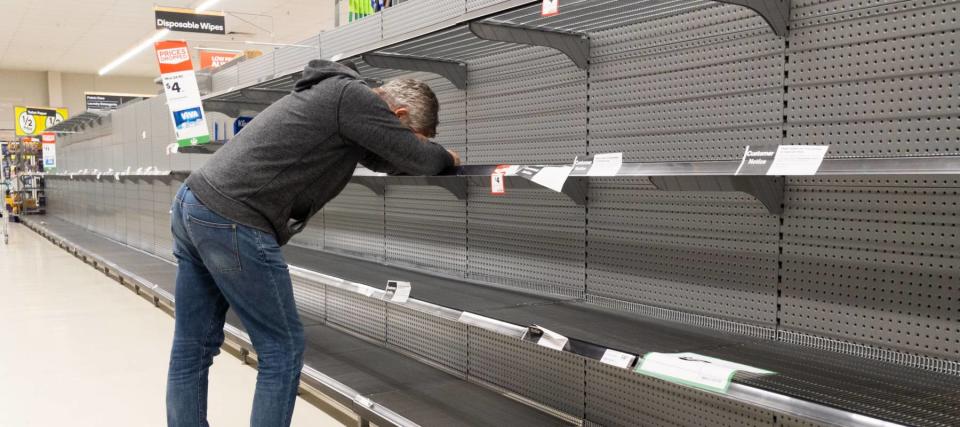Stores are preparing for a second wave of panic buying — and you should, too

Remember those long lines and bare shelves during the spring, when shoppers hoarded everything from toilet paper to canned soup?
They're back — thanks to an alarming increase in COVID-19 infections this fall.
Walmart finds itself fighting again to keep its aisles stocked, CEO Doug McMillon said on Monday during the online Yahoo Finance All Markets Summit.
"With the case counts coming back up there are some areas we see stock-up behavior again locally," McMillon said. "It will be choppy for months to come as we all deal with the volatility and as things change."
Here’s what stores including Walmart are doing to prepare for a second wave of panic buying — and what you should do, too.
Pay attention to changing habits

Even when people aren’t panicking and picking the shelves clean, the ways we eat and shop have changed significantly.
Adults and children are spending much more time at home, preparing their own meals. The average weekly grocery bill is now $190, up 17% from pre-pandemic levels, according to a September survey from LendingTree. That's why whenever you shop, make sure you're earning cash back for your purchases.
Grocery bills have jumped, even though shoppers are taking fewer trips. They’re simply stuffing their carts on the occasions when they do venture out.
If it's feeling like you can never find paper products, the data backs that up. Nearly half of survey respondents said they're buying more toilet paper and paper towels compared to last year.
Other big spending increases could provide clues to some of the shortages we can expect to see this winter. Following paper products, the LendingTree survey found that fresh produce, frozen food and canned goods saw the biggest jump in demand when the pandemic hit.
New items running low

Shoppers and retailers are reporting that certain items are already running low, including liquid hand soap, disinfecting wipes and canning jars (especially lids). Some products have been difficult to find ever since the first wave.
But a wintery second wave could trigger new shortages, as Americans spend even more time indoors. In a panel discussion with doctors from Harvard Medical School in September, White House adviser Dr. Anthony Fauci said Americans should prepare to “hunker down to get through this fall and winter.”
Beyond grocery goods, you can expect to see shortages of:
Exercise equipment: When gyms closed, it wasn’t easy to pick up items like free weights — and that was when pleasant temperatures allowed people to get outside.
Outdoor gear: Speaking of getting outside, expect a run on gloves, hats and any items that allow people to exercise outdoors.
Home appliances: It’s a perfect storm: an increase in home reno projects, lack of supply from store closures, COVID-19 protocols at manufacturing facilities and the usual holiday shopping could combine to create shortages on appliances big and small.
If you're planning to avoid stores and are doing most of your shopping online, install a free browser extension for Chrome that will automatically find you deals and coupon codes.
How stores are preparing

The level of panic might not be the same this winter, but even a little hoarding will aggravate the already high consumer demand during the holiday season. Thankfully, stores are planning ahead.
“Grocery stores and food retailers are stockpiling products to prepare for another widespread outbreak of COVID-19 cases,” said Edward McLaughlin, a professor of food industry management at Cornell University, in September.
Typically, stores make use of demand forecasting, triggering an order to the supplier at the last minute, just before the store stock is depleted, McLaughlin said. But companies were caught off guard when customers began hoarding, and inventory levels were too low to match huge spikes in demand.
“Retailers have learned key lessons from the pandemic,” added McLaughlin. “Shoppers will be loyal even if you don’t have the fancy extras (skinned, boned, lime-marinated chicken thighs) as long as you have the basics (chicken breasts).”
Instead of responding to demand, companies are now sending paper products, pasta, beans and holiday items to stores with no need for an order.
Save on shopping this winter

Retailers will likely put a limit on high-demand items early, so you may see fewer people walk away with carts full of toilet paper.
That said, it could be prudent to stock up on some specialty items, as stores focus on keeping an ample supply of staples.
If you do decide to make a few big grocery hauls, be sure to keep an eye out for deals and rewards so you don’t put an oversized dent in your savings during the holidays.
A free app will let you earn rewards just by snapping a photo of your receipt.
Points will automatically be added to your account, and when you’ve collected enough points, you can exchange them for gift cards from your favorite stores and brands.
That should take the sting out of what will be an extra challenging holiday shopping season.

